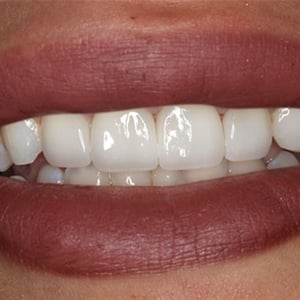Cavities as well as worn, broken, small/short and irregularly spaced teeth as well as badly-shaped, asymmetrical and crowded teeth poorly affect a smile’s aesthetics.
What is Dental Aesthetics?
Cavities as well as worn, stained, broken, crooked, small/short and irregularly spaced teeth as well as badly-shaped, asymmetrical and crowded teeth poorly affect a smile’s aesthetics. There may also be some aesthetic problems that cannot be treated with just fillings. Here, crowns fused to certain types of metals or non-metal empress, inceram or zirconia crowns can be used. In other cases, laminates can be used to treat aesthetic problems on the outward facing surface of the teeth. For diastema (gaps between the teeth), special aesthetic fillings that don’t require cutting into the teeth can be used to design a new, aesthetic smile.
Aesthetic dental treatments also include orthodontics, teeth whitening, composite fillings (using white light), implants and laser treatments.
Aesthetic dentistry is concerned not only with dental aesthetics but also discoloured, misshaped and receding gums, the shape of the lips and the general appearance of the mouth. Your dentist may therefore work in cooperation with gum disease experts, dermatologists and plastic surgeons to create a more aesthetically pleasing mouth and face. Such aesthetic treatments positively affect patient’s mental health and social lives.
What Factors can Influence an Aesthetic Smile?
- Horizontal Line Conformity: The pupils, corners of the lips and the teeth’s cutting edges should line up in parallel to each other.
- Smile Line: The curve formed by the cutting edges of the teeth should be symmetrical to the lower lip’s curve. The degree of symmetry influences how youthful and attractive a smile is.
- Gender and Tooth Shape:
- Women: The corners of the teeth are rounder while the smile line curves straight up.
- Men: The teeth are pointier while the smile line is straighter.
- Smile Symmetry: The mid line of the teeth should be straight and in line with the middle of the lips and the point of the nose.
- Teeth Arrangement: The teeth’s positioning is an important aspect of having a beautiful smile.
- Spacing: Gaps between the teeth poorly affect smiles.
- Colour: Pearl white teeth mean a younger and healthier smile.
- Size: Shorter teeth make people look older. Enlarging especially the front 2 incisors will make smiles look livelier and patients younger.
- Gum Health and Visibility: Prominent gums can negatively affect a smile’s aesthetics.
- Shape and Thickness of the Lips: These are important factors for an impressive smile and need to be taken into consideration when your new smile is being designed.
- Nose Shape: This too affects your smile and also needs to be taken into consideration when your new smile is being designed.
- The Golden Ratio: The golden ratio is the mathematical expression of the teeth in relation to each other and other surrounding factors mentioned above. Assuming the width of the front 2 incisors is 100, the teeth immediately next to them should have a width of 60, while the visible surface area of the subsequent 2 teeth should be 60% of those. Achieving this proportionality indicates an aesthetic smile has been achieved.
Aesthetic Problems
- Discoloured teeth
- Small, short and broken teeth
- Diastema (gaps between teeth)
- Misshaped gums
- Removal of dark brown spots on the gums
- Gummy smiles
- Crowded and mispositioned teeth
- Functional biting problems
- Sensitive, worn and/or receding gums
- Poor lip and smile lines
- Missing teeth
Aesthetic Treatments
- Teeth Whitening
- Composites
- Laminates (incl. porcelain laminates)
- Orthodontics
- Implants (incl. zirconium)
- Sensitivity Treatment
- Laser Treatments (including facial peeling
- Surgical treatment
- B0t0x






.jpeg)


